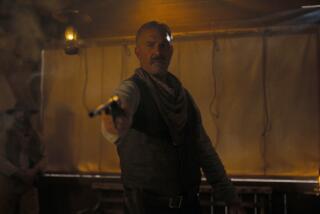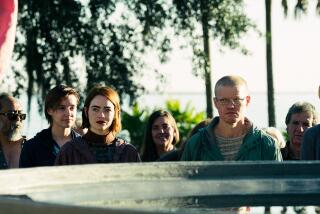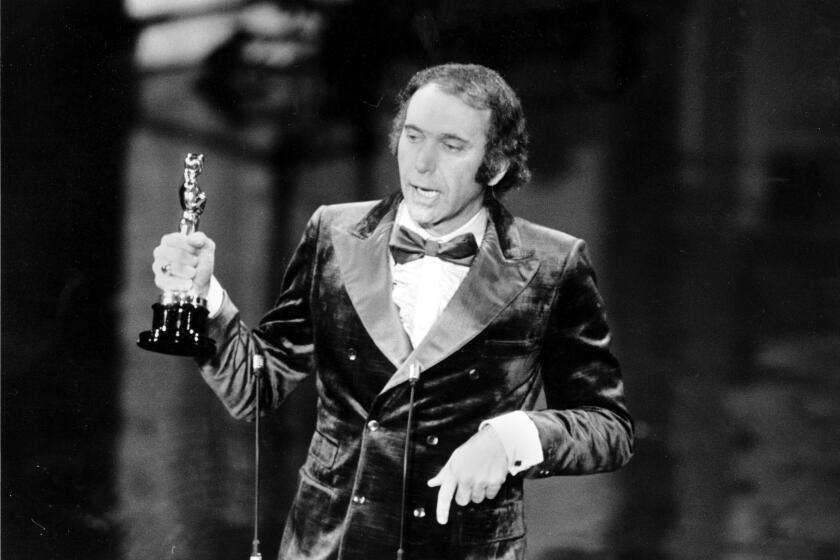‘SQUARE DANCE’: STEP BY STEP
If you are shopping a script around Hollywood in quest of financing and a producer says, “We’ve got half the money,” run like a deer, Dan Petrie says. “That’s buzz language that ranks with ‘Trust me.’ What it really means is, ‘If you can get half the money, maybe we can find the other half.’ ”
Petrie is a veteran director who has done fine work, characterized always by its sensitivity, in every medium there is. He did Frank Gilroy’s award-winning “Who’ll Save the Ploughboy” Off Broadway. Among his several movies are “A Raisin in the Sun” with Sidney Poitier and “Resurrection” with Ellen Burstyn. In an amazing list of television dramas, there are “The Dollmaker” with Jane Fonda, “Sybil” with Sally Field and Joanne Woodward and “Eleanor and Franklin, Parts I and II” with Jane Alexander and Edward Hermann.
You’d think something would get easier after you’d built a track record like that, but it is a central Hollywood truth that good work is not necessarily its own fiscal reward.
Petrie produced and directed “Square Dance,” which opened here last week to warming reviews, including an affable salute from Michael Wilmington in The Times.
It reunites Petrie with Jane Alexander, here in a vivid role several country miles west of Eleanor Roosevelt, as a good-time mother who has abandoned her daughter to chase dreams of gold amid the not-very-bright lights of Fort Worth.
It offers a remarkable debut by a Petaluma girl named Winona Ryder as the spunky daughter. It presents Rob Lowe, about as many country miles away from his pretty-boy brat-pack image as you can get, playing a sweet, severely retarded man-child whose mama runs a diner.
Jason Robards has a lesser turn as Alexander’s irascible farmer-father.
There would seem to have been some commercial mileage in the project somewhere, even before all the secondary casting was nailed down. Yet Petrie was saying at lunch last week that the project took years of disappointment, blood, sweat and tears before it finally became airborne.
Charles Haid, the Renko of “Hill Street Blues,” discovered the Alan Hines novel. Haid has helped produce several projects, including “Godspell” on stage and for television “Children of the Crossfire,” about Northern Ireland. He persuaded Alexander, who is also getting into motion picture development, to join him as co-executive producer.
They in turn recruited Petrie and began working with Hines on his scripting of his novel. Emilio Estevez was eager to do the boy’s part, but the chance to make and star in his own film, “Wisdom,” came along and drew him away.
Lowe got hold of the script on his own and, through his agent, offered to do the part. He was asked to audition. Before he did, he spent a week talking with retarded young people and their psychiatrists and speech pathologists. He auditioned brilliantly, Petrie says, and then agreed to do the role for roughly 1/20th of his going price--all the budget would stand.
The project might still have languished if Michael Nesmith, the former Monkee who has gone into video and film production, had not joined the project. Within a week he had come up with the balance of the money, from his own Pacific Arts company and from Brandon Tartikoff at NBC Productions, making their first feature film investment. Island had agreed to distribute, once the financing was in place.
The result is a title crawl longer than a used-car contract. But “Square Dance” got made, for what by present standards is pennies (under $5 million), on location in Fort Worth and elsewhere in Texas.
“Rob Lowe was a risk,” Petrie says. “If he weren’t really good in the part, our using him would smack of commercialism, even though the girls who come to see Rob Lowe as Rob Lowe are going to be severely disappointed. As it is, we’ve had walkouts by his fans at a couple of the screenings.
“But in my judgment what you see in his work is the inhabitation of a soul. Rob came in extremely well prepared. He’d spent time at a hospital with these 15-, 20-, 30-year-old disturbed children. He’d seen their sweetness and he’d listened to them. In fact, at the audition he had got their speech so well that we had trouble understanding him. I had to stop him and say, ‘You’ve got to think him, not sound him.”’
Petrie, who is from Nova Scotia, did an autobiographical film a couple of years ago called “The Bay Boy,” with Liv Ullmann, about a difficult growing-up in hard times. The environment of “Square Dance” is wildly different, yet there are spiritual links in the stubborn individuality of the girl and the pains of self-discovery, in the economic troubles, in the dawning awareness of the power of sex (understood, not indulged) and in the final confirmation of the crucial importance of family love.
The world that Petrie and Alan Hines have drawn in “Square Dance” is as real as a tough chicken-fried steak. It is not prettified and does not proclaim that everybody will live happily ever after. But it suggests that values are where you find them, often in unlikely surroundings, and that survival is hard but possible.
“Square Dance” isn’t perfect; the square dance of the title is a strained metaphor, as a matter of fact. But the film makes hope as credible as despair, and triumph at least as possible as defeat. A bittersweet affirmation is not half-bad.
Once again, “Square Dance” proves that, in present motion pictures, originality and vitality, daring and integrity are to be found in the independent sector--where drive and devotion do what the missing dollars can’t.
More to Read
Only good movies
Get the Indie Focus newsletter, Mark Olsen's weekly guide to the world of cinema.
You may occasionally receive promotional content from the Los Angeles Times.






